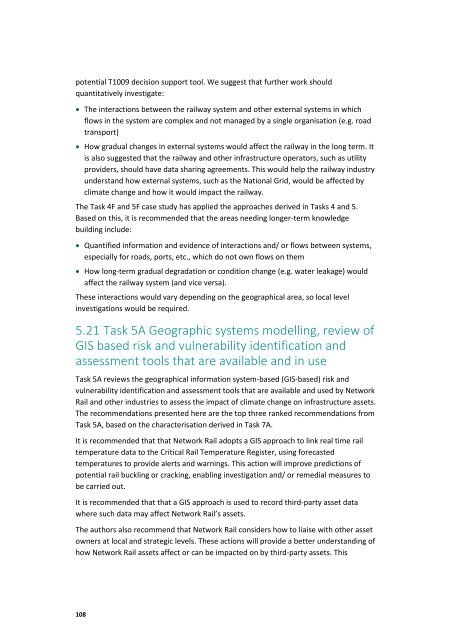Tomorrow's Railway and Climate Change Adaptation Final Report
2016-05-T1009-final-report
2016-05-T1009-final-report
You also want an ePaper? Increase the reach of your titles
YUMPU automatically turns print PDFs into web optimized ePapers that Google loves.
potential T1009 decision support tool. We suggest that further work should<br />
quantitatively investigate:<br />
• The interactions between the railway system <strong>and</strong> other external systems in which<br />
flows in the system are complex <strong>and</strong> not managed by a single organisation (e.g. road<br />
transport)<br />
• How gradual changes in external systems would affect the railway in the long term. It<br />
is also suggested that the railway <strong>and</strong> other infrastructure operators, such as utility<br />
providers, should have data sharing agreements. This would help the railway industry<br />
underst<strong>and</strong> how external systems, such as the National Grid, would be affected by<br />
climate change <strong>and</strong> how it would impact the railway.<br />
The Task 4F <strong>and</strong> 5F case study has applied the approaches derived in Tasks 4 <strong>and</strong> 5.<br />
Based on this, it is recommended that the areas needing longer-term knowledge<br />
building include:<br />
• Quantified information <strong>and</strong> evidence of interactions <strong>and</strong>/ or flows between systems,<br />
especially for roads, ports, etc., which do not own flows on them<br />
• How long-term gradual degradation or condition change (e.g. water leakage) would<br />
affect the railway system (<strong>and</strong> vice versa).<br />
These interactions would vary depending on the geographical area, so local level<br />
investigations would be required.<br />
5.21 Task 5A Geographic systems modelling, review of<br />
GIS based risk <strong>and</strong> vulnerability identification <strong>and</strong><br />
assessment tools that are available <strong>and</strong> in use<br />
Task 5A reviews the geographical information system-based (GIS-based) risk <strong>and</strong><br />
vulnerability identification <strong>and</strong> assessment tools that are available <strong>and</strong> used by Network<br />
Rail <strong>and</strong> other industries to assess the impact of climate change on infrastructure assets.<br />
The recommendations presented here are the top three ranked recommendations from<br />
Task 5A, based on the characterisation derived in Task 7A.<br />
It is recommended that that Network Rail adopts a GIS approach to link real time rail<br />
temperature data to the Critical Rail Temperature Register, using forecasted<br />
temperatures to provide alerts <strong>and</strong> warnings. This action will improve predictions of<br />
potential rail buckling or cracking, enabling investigation <strong>and</strong>/ or remedial measures to<br />
be carried out.<br />
It is recommended that that a GIS approach is used to record third-party asset data<br />
where such data may affect Network Rail’s assets.<br />
The authors also recommend that Network Rail considers how to liaise with other asset<br />
owners at local <strong>and</strong> strategic levels. These actions will provide a better underst<strong>and</strong>ing of<br />
how Network Rail assets affect or can be impacted on by third-party assets. This<br />
108


